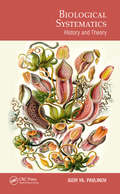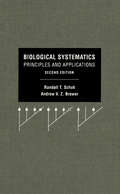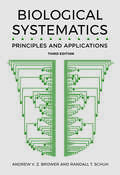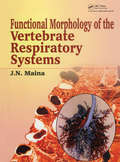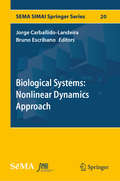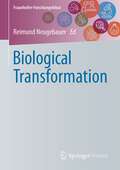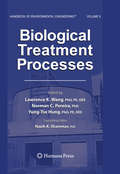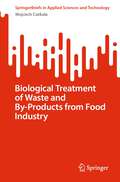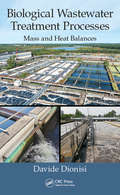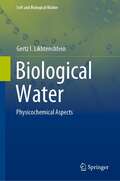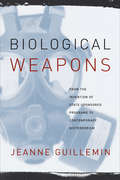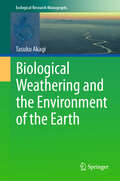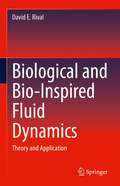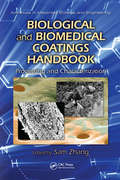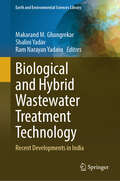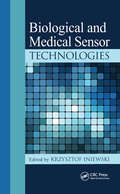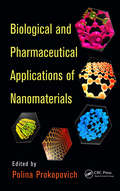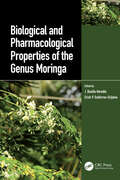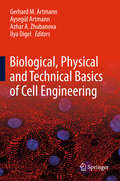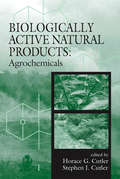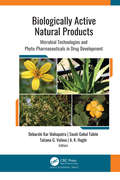- Table View
- List View
Biological Systematics: History and Theory (Species and Systematics)
by Igor PavlinovThis volume reviews the historical roots and theoretical foundations of biological systematics in an approachable text. The author outlines the structure and main tasks of systematics. Conceptual history is characterized as a succession of scientific revolutions. The philosophical foundations of systematic research are briefly reviewed as well as the structure and content of taxonomic theories. Most important research programs in systematics are outlined. The book includes analysis of the principal problematic issues as "scientific puzzles" in systematics. This volume is intended for professional taxonomists, biologists of various specialties, students, as well as all those interested in the history and theory of biology and natural sciences.Key Features Considers the conceptual history of systematics as the framework of evolutionary epistemology Builds a hierarchically organized quasi-axiomatic system of taxonomic theory Contends that more reductionist taxonomic concepts are less objective Supports taxonomic pluralism by non-classic philosophy of science as a normal condition of systematics Documents that "taxonomic puzzles" result from conflict between monistic and pluralistic attitudes Related Titlesde Queiroz, K. et al., eds. Phylonyms: A Companion to the PhyloCode (ISBN 978-1-1383-3293-5)Sigwart, J. D. What Species Mean: A User's Guide to the Units of Biodiversity (ISBN 978-1-4987-9937-9)Rieppel, O. Phylogenetic Systematics: Haeckel to Hennig (ISBN 978-1-4987-5488-0)Wilkins, J. S. Species: The Evolution of the Idea, 2nd ed. (ISBN 978-1-1380-5574-2)
Biological Systematics: Principles and Applications
by Randall T. Schuh Andrew V. BrowerBiological Systematics: Principles and Applications draws equally from examples in botany and zoology to provide a modern account of cladistic principles and techniques. It is a core systematics textbook with a focus on parsimony-based approaches for students and biologists interested in systematics and comparative biology. Randall T. Schuh and Andrew V. Z. Brower cover: -the history and philosophy of systematics and nomenclature;-the mechanics and methods of analysis and evaluation of results;-the practical applications of results and wider relevance within biological classification, biogeography, adaptation and coevolution, biodiversity, and conservation; and-software applications.This new and thoroughly revised edition reflects the exponential growth in the use of DNA sequence data in systematics. New data techniques and a notable increase in the number of examples from molecular systematics will be of interest to students increasingly involved in molecular and genetic work.
Biological Systematics: Principles and Applications
by Randall T. Schuh Andrew V. BrowerUnderstanding the history and philosophy of biological systematics (phylogenetics, taxonomy and classification of living things) is key to successful practice of the discipline. In this thoroughly revised Third Edition of the classic Biological Systematics, Andrew V. Z. Brower and Randall T. Schuh provide an updated account of cladistic principles and techniques, emphasizing their empirical and epistemological clarity. Brower and Schuh cover: -the history and philosophy of systematics -the mechanics and methods of character analysis, phylogenetic inference, and evaluation of results -the practical application of systematic results to: -biological classification -adaptation and coevolution -biodiversity,and conservation -new chapters on species and molecular clocks Biological Systematics is both a textbook for students studying systematic biology and a desk reference for practicing systematists. Part explication of concepts and methods, part exploration of the underlying epistemology of systematics, This third edition addresses why some methods are more empirically sound than others.
Biological Systems in Vertebrates, Vol. 1: Functional Morphology of the Vertebrate Respiratory Systems (Biological Systems In Vertebrates Ser. #Vol. 1)
by J N MainaGives an account of the morphologies of vertebrate respiratory organs and attempts to explicate the basis of the common and different structural and functional designs and stratagems that have evolved for acquisition of molecular oxygen. The book has been written with a broad readership in mind: students of biology as well as experts in the disciplines of zoology, physiology, morphology, biological microscopy, biomedical engineering, and ecology and those that work or may contemplate working on materials and aspects concerning respiration in whole organisms will find it useful. Scientists in earth sciences with particular interest on the outcomes of past interactions between environmental factors (the physical domain) and evolution and adaptation (the biological domain), mechanisms that have set the composition, patterning, and anatomies of extant animal life, will find the book of interest.
Biological Systems: Nonlinear Dynamics Approach (SEMA SIMAI Springer Series #20)
by Jorge Carballido-Landeira Bruno EscribanoThis book collects recent advances in the field of nonlinear dynamics in biological systems. Focusing on medical applications as well as more fundamental questions in biochemistry, it presents recent findings in areas such as control in chemically driven reaction-diffusion systems, electrical wave propagation through heart tissue, neural network growth, chiral symmetry breaking in polymers and mechanochemical pattern formation in the cytoplasm, particularly in the context of cardiac cells. It is a compilation of works, including contributions from international scientists who attended the “2nd BCAM Workshop on Nonlinear Dynamics in Biological Systems,” held at the Basque Center for Applied Mathematics, Bilbao in September 2016. Embracing diverse disciplines and using multidisciplinary approaches – including theoretical concepts, simulations and experiments – these contributions highlight the nonlinear nature of biological systems in order to be able to reproduce their complex behavior. Edited by the conference organizers and featuring results that represent recent findings and not necessarily those presented at the conference, the book appeals to applied mathematicians, biophysicists and computational biologists.
Biological Transformation
by Reimund NeugebauerThe global population is expected to rise to 9.8 billion by the year 2050 - with everyone ultimately striving for prosperity. New methods must therefore be found to achieve more efficient production. Research to date shows that the biological inventory that has evolved: its products, processes, principles and tools, can spur modern technology. The development of technological innovations based on biological concepts, with the goal of particularly innovative and sustainable value creation, today is collectively known as "biological transformation". It results in highly functional products with striking properties that can be both manufactured and utilized in a resource-saving way.In terms of taking responsibility of the good of all people, biological transformation is therefore a path that applied research will have to take. The Fraunhofer-Gesellschaft has recognized the developmental technology potential of biological transformation and sees it as its task not only to drive the relevant research forward, but also to promote public awareness of the topic.
Biological Treatment Processes: Volume 8 (Handbook of Environmental Engineering #8)
by Lawrence K. Wang Yung-Tse Hung Nazih K. Shammas Norman C. PereiraPollution and its effects on the environment have emerged as critical areas of research within the past 30 years. The Handbook of Environmental Engineering is a collection of methodologies that study the effects of pollution and waste in their three basic forms: gas, solid, and liquid. In Volume 8, Biological Treatment Processes, tried-and-true solutions comprise a "methodology of pollution control". The distinguished panel of authors contributes detailed chapters, which include topics ranging from treatment by land application, activated sludge processes, and submerged aeration to trickling filters, lagoons, rotating biological contactors, sequencing batch reactors, digestions, and composting. Volume 8 and its sister book - Volume 9: Advanced Biological Treatment Processes - are designed as both basic biological waste treatment textbooks and reference books for advanced undergraduate and graduate students - as well as for designers of waste treatment systems, scientists, and researchers. An indispensable addition to the Humana Press series, Volume 8: Biological Treatment Processes provides an illuminating look at water pollution control and the fascinating evolution of bio-environmental engineering.
Biological Treatment of Waste and By-Products from Food Industry (SpringerBriefs in Applied Sciences and Technology)
by Wojciech CzekałaThis book discusses selected waste and by-products of the food industry. Two commonly used methods of managing these are discussed: anaerobic digestion and composting. The book reviews current research and also brings in the author’s own research insights to the discussion. The book is aimed at food industry specialists, waste management specialists, scientists, and students. However, the book describes problems in an accessible way, which will make this book useful for beginners in the waste/biogas/composting sector.
Biological Variation in Health and Illness: Race, Age, and Sex Differences (CRC Press Revivals)
by Theresa OverfieldSpecifically for the health professional, this book contains an extensive compilation of research findings on biologic variation by race, age, and gender relating to health and illness. Completely rewritten, revised, and updated, the Second Edition includes an increased discussion of biologic variation and expanded coverage of each chapter topic.This book provides a theoretical framework for understanding the mechanisms that influence biologic variation. It presents a well-documented discussion of research data and indicates areas where knowledge is lacking. A theoretical explanation is followed by examination of surface and anatomical variations, developmental variation, biochemical and enzymatic variations, disease susceptibility differences, and influence of the external variation. Consideration of sexual variation reveals more differences between the sexes than among races. Misconceptions about racial uniformity and diversity are exposed throughout the book. Tables of specific biologic variations allow easy reference and access to the literature.
Biological Wastewater Treatment Processes: Mass and Heat Balances
by Davide DionisiThe focus of the book is on how to use mass and heat balances to simulate and design biological wastewater treatment processes. All the main processes for biological wastewater treatment are covered viz. activated sludge processes for carbon and nitrogen removal, anaerobic digestion, sequencing batch reactors, and attached growth processes.
Biological Water: Physicochemical Aspects (Soft and Biological Matter)
by Gertz I. LikhtenshteinThis book embraces all physiochemical aspects of the structure and molecular dynamics of water, focusing on its role in biological objects, e.g. living cells and tissue, and in the formation of functionally active structures of biological molecules and their ensembles. Water is the single most abundant chemical found in all living things. It offers a detailed look into the latest modern physical methods for studying the molecular structure and dynamics of the water and provides a critical analysis of the existing literature data on the properties of water in biological objects. Water as a chemical reagent and as a medium for the formation of conditions for enzymatic catalysis is a core focus of this book. Although well suited for active researchers, the book as a whole, as well as each chapter on its own, can be used as fundamental reference material for graduate and undergraduate students throughout chemistry, physics, biophysics and biomedicine.
Biological Weapons: From the Invention of State-Sponsored Programs to Contemporary Bioterrorism (Columbia Contemporary Issues In National Security Policy)
by Jeanne GuilleminUntil the events of September 11 and the anthrax attacks of 2001, biological weapons had never been a major public concern in the United States. Today, the possibility of their use by terrorists against Western states looms large as an international security concern. In Biological Weapons, Jeanne Guillemin provides a highly accessible and compelling account of the circumstances under which scientists, soldiers, and statesmen were able to mobilize resources for extensive biological weapons programs and also analyzes why such weapons, targeted against civilians, were never used in a major conflict. This book is essential for understanding the relevance of the historical restraints placed on the use of biological weapons for today's world. It serves as an excellent introduction to the problems biological weapons pose for contemporary policymakers and public officials, particularly in the United States. How can we best deter the use of such weapons? What are the resulting policies of the Department of Homeland Security? How can we constrain proliferation? Jeanne Guillemin wisely points out that these are vitally important questions for all Americans to consider and investigate—all the more so because the development of these weapons has been carried out under a veil of secrecy, with their frightening potential open to exploitation by the media and government. Public awareness through education can help calm fears in today's tension-filled climate and promote constructive political action to reduce the risks of a biological weapons catastrophe.Biological Weapons is required reading for every concerned citizen, government policymaker, public health official, and national security analyst who wants to understand this complex and timely issue.
Biological Weathering and the Environment of the Earth (Ecological Research Monographs)
by Tasuku AkagiThis book introduces the concept of 'biological weathering.' Weathering, especially chemical weathering, has been recognized as one of the most important processes on Earth because it influences the circulation of elements, including carbon. Weathering has almost always been considered an abiotic process. The book describes the author’s experiments, proving that plant involvement in weathering is a strategy for plants to ingest nutrients from rocks. It is also shown through cultivation experiments and observation of natural diatoms that diatoms and silica obligate plankton dissolve silicate minerals and incorporate silicon and other elements into their frustules. The weathering reaction has also been successfully applied to the previously unexplained relationship between carbon and silica in the ocean’s interior. Readers of this book will gain a comprehensive understanding of weathering as a reaction catalyzed by both plants and plankton, occurring not only on land but also ubiquitously in the earth’s environment, including the ocean’s interior. This new and novel perspective has significant implications for various scientific fields, including biology, marine chemistry, environmental, and paleoenvironmental sciences. The author underscores the immediate relevance of these findings to pressing issues surrounding atmospheric CO2. The book concludes with a proposal for an efficient and safe method to sequester CO2 in the atmosphere into the ocean interior, offering a practical solution to a global challenge. The target audience for this book includes students and researchers in ecology, evolutionary biology, geochemistry, environment and plant sciences, atmospheric sciences, and Geo-industries.
Biological and Bio-Inspired Fluid Dynamics: Theory and Application
by David E. RivalThis text provides the reader with tools necessary to study biological and bio-inspired flows, all the while developing an appreciation for their evolutionary and engineering constraints. It is suitable for students already exposed to introductory concepts in fluid mechanics and applied mechanics as a whole, but who would not need an advanced training in fluid mechanics per se. Currently no textbook exists that can take students from an introductory position in fluid mechanics to these contemporary topics of interest. The book is ideal for upper-level undergraduates and graduate students studying a range of engineering domains as well as biology, or even medicine.
Biological and Biomedical Coatings Handbook: Applications (Advances in Materials Science and Engineering)
by Sam ZhangWritten in a versatile, contemporary style that will benefit both novice and expert alike, Biological and Biomedical Coatings Handbook, Two-Volume Set covers the state of the art in the development and implementation of advanced thin films and coatings in the biological field. Consisting of two volumes-Processing and Characterization and Applicatio
Biological and Biomedical Coatings Handbook: Processing and Characterization
by Sam ZhangWritten in a versatile, contemporary style that will benefit both novice and expert alike, Biological and Biomedical Coatings Handbook, Two-Volume Set covers the state of the art in the development and implementation of advanced thin films and coatings in the biological field. Consisting of two volumes-Processing and Characterization and Applicatio
Biological and Hybrid Wastewater Treatment Technology: Recent Developments in India (Earth and Environmental Sciences Library)
by Shalini Yadav Ram Narayan Yadava Makarand M. GhangrekarThis book provides technical information on different biological and hybrid wastewater treatment systems for the treatment of wastewater and reuse, and tracks their progress towards practical and field-scale applications including strategies to be adopted for minimizing the losses and maximizing the benefits, as well as protecting the environment through the application of advanced biological and hybrid wastewater treatment Technology. In addition, it discusses the crucial parts that science, technology, and innovation play in the formulation, implementation, and administration of wastewater treatment policy. It highlights the challenges that must be overcome to adopt biological and hybrid wastewater treatment infrastructure regulations successfully and provides some answers. Also, it investigates how the biological and hybrid wastewater treatment technology may be used in a wide variety of field's sets apart from other on-the-shelf publications on the market. Also, it delves into the core concepts of Biological and Hybrid Wastewater Treatment Systems. It explores how these concepts can be modified to fit a variety of contexts and uses. Applications such as managing facilities, dealing with pandemics, urban wastewater treatment and reuse, farming, and other applications are included in this book. As a consequence, this book's content is engaging, and it will pique the interest of a diverse audience of readers who come from a wide variety of different professional backgrounds. Therefore, the book is written by local experts in the topic who dealing with the treatment of wastewater treatment technologies for a long time in India. This book will be helpful to researchers, entrepreneurs, professionals, planners, policymakers, environmental engineers, and others interested in biological and hybrid wastewater treatment system management strategies through the application of breakthroughs in biological and hybrid wastewater treatment technologies.
Biological and Medical Sensor Technologies (Devices, Circuits, and Systems)
by Krzysztof IniewskiBiological and Medical Sensor Technologies presents contributions from top experts who explore the development and implementation of sensors for various applications used in medicine and biology. Edited by a pioneer in the area of advanced semiconductor materials, the book is divided into two sections. The first part covers sensors for biological applications. Topics include: Advanced sensing and communication in the biological world DNA-derivative architectures for long-wavelength bio-sensing Label-free silicon photonics Quartz crystal microbalance-based biosensors Lab-on-chip technologies for cell-sensing applications Enzyme biosensors Future directions for breath sensors Solid-state gas sensors for clinical diagnosis The second part of the book deals with sensors for medical applications. This section addresses: Bio-sensing and human behavior measurements Sweat rate wearable sensors Various aspects of medical imaging The future of medical imaging Spatial and spectral resolution aspects of semiconductor detectors in medical imaging CMOS SSPM detectors CdTe detectors and their applications to gamma-ray imaging Positron emission tomography (PET) Composed of contributions from some of the world’s foremost experts in their respective fields, this book covers a wide range of subjects. It explores everything from sensors and communication systems found in nature to the latest advances in manmade sensors. The end result is a useful collection of stimulating insights into the many exciting applications of sensor technologies in everyday life.
Biological and Pharmaceutical Applications of Nanomaterials
by Polina ProkopovichBiological and Pharmaceutical Applications of Nanomaterials presents the findings of cutting-edge research activities in the field of nanomaterials, with a particular emphasis on biological and pharmaceutical applications. Divided into four sections-nanomaterials for drug delivery, antimicrobial nanomaterials, nanomaterials in biosensors, and safet
Biological and Pharmacological Properties of the Genus Moringa
by J. Basilio HerediaThere is an increasing interest in plants of the Moringa genus used as a source of phytochemicals with biopharmaceutical potential, as a functional ingredient in many products and as an additive in poultry feeding stocks. Biological and Pharmacological Properties of the Genus Moringa is the first publication to comprehensively assess the latest research on Moringa studies. This book reviews recent studies covering the botanical, agronomical, genomic, biotechnological, and ethnopharmacological aspects. It presents specialized work in a user-friendly way that will appeal to undergraduates, graduates and researchers primarily in ethnopharmacology, functional foods and with a linkage to veterinary treatments. Key Features: Describes the ethnopharmacological and ethnobotanical use of plants from all Moringa species Presents recent information that will be helpful for the future development of biopharmaceuticals Reviews the phytochemical content from all Moringa species Assesses the potential of all Moringa species as a functional ingredient
Biological sequence analysis
by Richard Durbin Sean R. Eddy Anders Krogh Graeme MitchisonProbabilistic models are becoming increasingly important in analysing the huge amount of data being produced by large-scale DNA-sequencing efforts such as the Human Genome Project. For example, hidden Markov models are used for analysing biological sequences, linguistic-grammar-based probabilistic models for identifying RNA secondary structure, and probabilistic evolutionary models for inferring phylogenies of sequences from different organisms. This book gives a unified, up-to-date and self-contained account, with a Bayesian slant, of such methods, and more generally to probabilistic methods of sequence analysis. Written by an interdisciplinary team of authors, it aims to be accessible to molecular biologists, computer scientists, and mathematicians with no formal knowledge of the other fields, and at the same time present the state-of-the-art in this new and highly important field.
Biological, Diagnostic and Therapeutic Advances in Alzheimer's Disease: Non-Pharmacological Therapies for Alzheimer's Disease
by Athanasios Alexiou Ghulam Md AshrafThis book discusses the latest research into the highly prevalent neurodevelopmental disease most commonly associated with aging: Alzheimer’s disease (AD). Even after years of research, Alzheimer’s disease is still far from being cured. It presents a range of common symptoms in the form of behavioral and cognitive impairments. This book describes the symptoms and the biology behind them. The contents covers latest findings on the genetics involved and various factors and pathways influencing disease development. It also covers various non-pharmacological therapies like immunotherapy, use of natural products, and employing nanotechnology in both the detection and treatment of AD. This book also highlights the role of diet and nutrition in healthy aging. Given its scope, it offers a valuable asset for researchers and clinicians alike.
Biological, Physical and Technical Basics of Cell Engineering
by Gerhard M. Artmann Aysegül Artmann Azhar A. Zhubanova Ilya DigelThis book presents and discusses recent scientific progress on Cell and Stem Cell Engineering. It predominantly focuses on Biological, Physical and Technical Basics, and features new trends of research reaching far into the 21st century.
Biologically Active Natural Products: Agrochemicals
by Horace G. Cutler Stephen J. CutlerNatural products that have both plant growth regulatory properties and pharmaceutical properties are examined in this book. This is the first and most up-to-date text linking agrochemistry and pharmaceutical chemistry in an easy to read presentation for practitioners in both fields. Due to the intense and widespread attention being given to
Biologically Active Natural Products: Microbial Technologies and Phyto-Pharmaceuticals in Drug Development
by Debarshi Kar Mahapatra; Swati Gokul Talele; Tatiana G. Volova; A. K. HaghiBiologically active natural products and their substructures have long been valuable starting points for medicinal chemistry and drug discovery. This new volume explores biologically active natural products and their use in microbial technologies and as phyto-pharmaceuticals in drug development. It presents detailed scientific principles and recent research on applications of nanotechnology in diagnostics and drug delivery. Topics include pharmacotherapeutically active proteins and peptides; the biotechnological potential of hydrogen-oxidizing bacteria; synthesis and production; synthetic colorants, pigments, dyes, and lakes; and more. The use of various plants is discussed in several chapters, including Artemisia, Asteraceae, Abutilon indicum, Prosopis juliflora, Acacia arabica, Aloe barbadensis, Tabermontana divaricate Linn., among others. With the information presented in Biologically Active Natural Products: Microbial Technologies and Phyto-Pharmaceuticals in Drug Development, scientists, faculty, and graduate students will gain a unique insight into nanotechnology and natural pharmaceuticals today with practical implementation in various industrial sectors.
